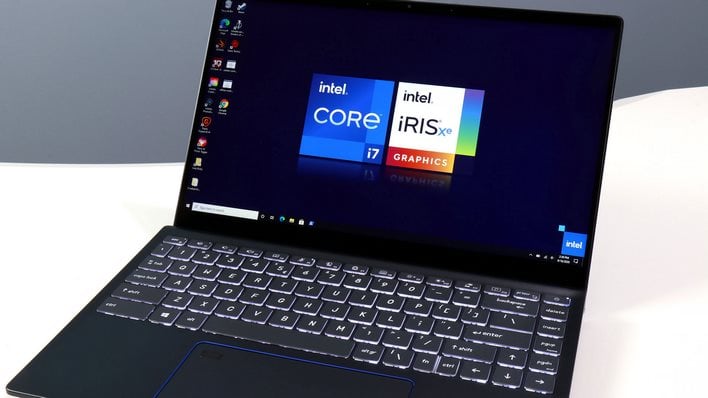Intel Tiger Lake And Xe Graphics Benchmarks: Laptops Will Roar
Here's Intel's Tiger Lake 11th Gen Core Processor And It's Ready To Roar
Intel has been showcasing its forthcoming Tiger Lake mobile processor line-up since its public debut in January of this year at CES. However, more recently the company disclosed the architecture powering the 11th Gen Core series CPUs at its Architecture Day 2020 event and then followed-up quickly with a full product stack unveil. To say anticipation is high for this product would be an understatement. Intel has a lot riding on Tiger Lake, with its Willow Cove cores and more importantly perhaps, its 10nm SuperFin transistors and Xe Graphics technologies that will underpin a whole new family of products eventually, far beyond the company’s Tiger Lake mobile offering. We suppose you could say SuperFin and Tiger Lake is 10nm done right for Intel.
In fact, Intel claims its 10nm SuperFin offers the “largest intranode performance delta” in company history. These are bold claims to be sure, and Intel is also claiming a 20 percent performance uplift, which is a combination of both IPC improvement and clock speed gains at similar or lower voltages and power. Beyond SuperFin, Intel took its original Sunny Cove core architecture found in Ice Lake 10th Gen processors, and made a few tweaks along the way, resulting in Willow Cove that offers a larger, non-inclusive L1 cache, improved memory and fabric efficiency and bandwidth, and Intel’s new Iris Xe graphics based on the company’s Gen12 Xe-LP GPU architecture, for “massive improvements” in graphics performance and efficiency as well.


That’s not to mention that Tiger Lake also brings with it leading-edge IO connectivity in the form of Thunderbolt 4, USB 4 and yes, PCI Express Gen 4 as well. Tiger Lake has all the 4s going on, you might say.
Of course, it’s easy for us to spit fab process, CPU and system architecture specs at you. What you really came here for is a view of Tiger Lake performance, and that you shall receive on the pages ahead. We have to get one more set of specs out of the way first, however, and that would be of our Intel Tiger Lake pre-production test system…

What Intel sent us for testing is what most of you would classify as a premium laptop configuration, complete with a 1TB high speed PCIe Gen 3 SSD, not PCIe 4.0 mind you, but still a fast Samsung NVMe SSD that's rated for north of 3GB/sec of read/write bandwidth. Also on board is 16GB of LPDDR4X memory in a dual channel configuration at 4266MHz for notably more memory bandwidth than standard previous gen Ice Lake configurations at 3733MHz. And of course we're also packing Intel Iris Xe graphics here, or Xe-LP in Intel speak, with its 96 Execution Units. Intel claims Xe-LP is up to twice as powerful as the Iris Plus graphics on board Ice Lake 10th Gen derivatives.
Finally, the host CPU is none other than the new Intel Tiger Lake-based Core i7-1185G7, which you can consider the successor to Intel's previous gen Ice Lake flavor of Core i7-1065G7. Like the Ice Lake variant, the Core i7-1185G7 is a quad-core beast, but this updated chip turbos up to 4.8GHz from its base clock of 3GHz. Though its boost clock is indeed almost a full 1GHz higher than a Core i7-1065G7, the Core i7-1185G7 also sports a dramatically higher base clock as well, as an Ice Lake Core i7-1065G7 clocks in at just 1.3GHz at its base.
But how does Intel skin all this horsepower in a modern day thin and light laptop? Well, for starters anyway, a little like this...
Finally, the host CPU is none other than the new Intel Tiger Lake-based Core i7-1185G7, which you can consider the successor to Intel's previous gen Ice Lake flavor of Core i7-1065G7. Like the Ice Lake variant, the Core i7-1185G7 is a quad-core beast, but this updated chip turbos up to 4.8GHz from its base clock of 3GHz. Though its boost clock is indeed almost a full 1GHz higher than a Core i7-1065G7, the Core i7-1185G7 also sports a dramatically higher base clock as well, as an Ice Lake Core i7-1065G7 clocks in at just 1.3GHz at its base.
But how does Intel skin all this horsepower in a modern day thin and light laptop? Well, for starters anyway, a little like this...
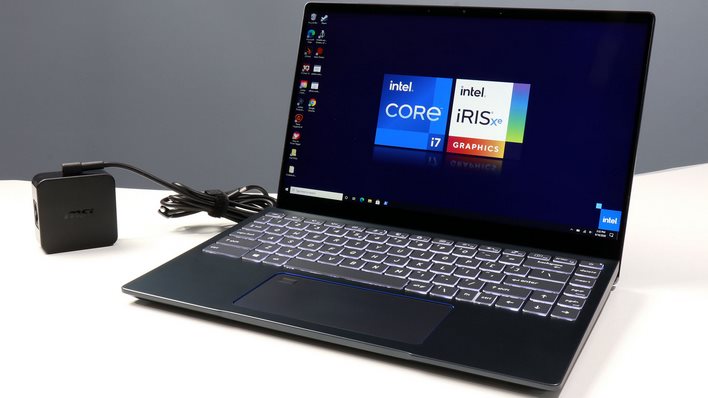
What you're looking at here is a 14-inch MSI laptop, in what appears to be the Prestige 14 series of machines, that weighs in at just 2.64 lbs in current non-Tiger Lake variants at least. So yes, this is truly a thin and light form factor and for our purposes, it's about as thin and light as a Lenovo ThinkPad X1 Carbon. We'd offer that the ThinkPad is maybe touch on the lighter side, due to its carbon fiber construction, but only by a sliver and this MSI machine is every bit as thin.
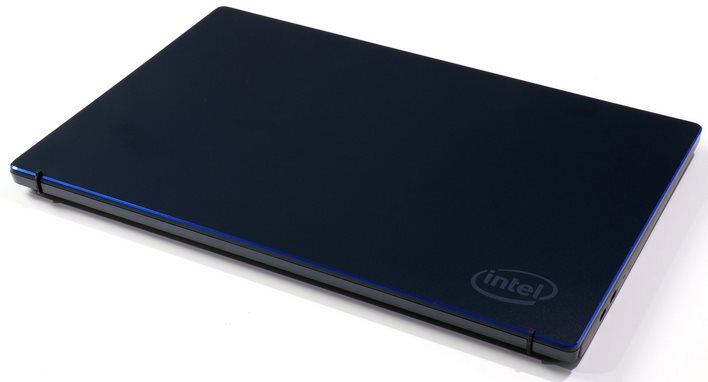
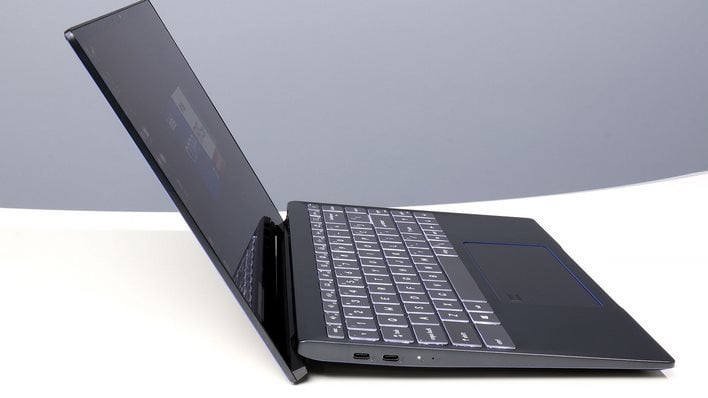
That is to say, generally speaking, in its closed position this well under 3 pound machine will slip into the most svelte of laptop bags or backpacks. Although, when its extended in the upward position, this machine certainly has optimal airflow underneath, where it draws cool air in from the bottom.
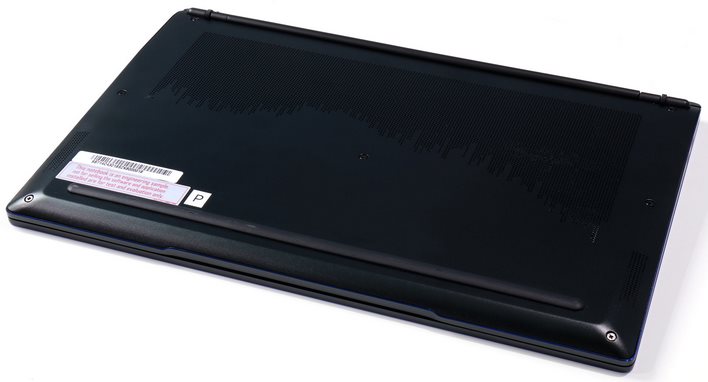
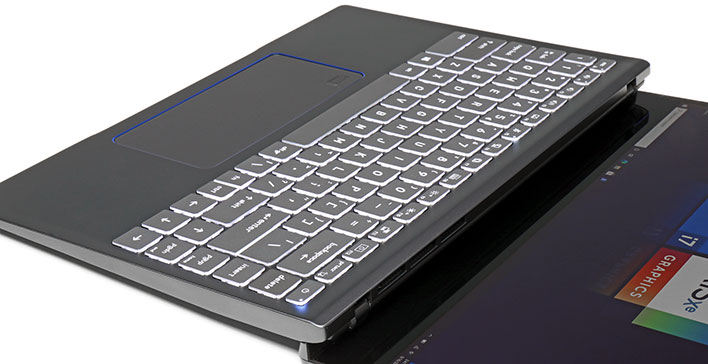
But before you pass this off as stacking the physics deck for Tiger Lake, it's actually a design that makes a lot of sense, as it also works well ergonomically, tilting the keyboard slightly up toward the user. As you can see above, the bottom of the machine is perforated well for pulling cool air in, though the venting area of this laptop chassis is relatively conservative.
So, there you have it. We've got your speeds, feeds and specs all covered, as well as the physical incarnation of an engineering reference sample system featuring Intel's next-gen Tiger Lake mobile platform. What do you say we dial-up some benchmarks? Right then, let's get it on...
So, there you have it. We've got your speeds, feeds and specs all covered, as well as the physical incarnation of an engineering reference sample system featuring Intel's next-gen Tiger Lake mobile platform. What do you say we dial-up some benchmarks? Right then, let's get it on...
Competitive Test Group And Methodology For Comparison With Intel Tiger Lake
For the following complete set of benchmark comparisons we've pulled in various laptops from a few different manufacturers, and also across a few vintages of mobile platforms. We also have a mix of both Intel and AMD platforms, as well as 4, 6 and 8-core CPUs represented here. In every case, competitive machines represented are retail products, while again, the Intel Core 7-1185G7 Tiger Lake machine is a pre-production engineering test sample. Finally, of course all of these machines may have slightly different configurations of system memory and storage, that can affect performance in some way. However, much of our testing focuses on either CPU and GPU-specific workloads that should limit this variability somewhat. In addition, in some of our benchmark comparisons, we've culled down the test group to only specific platforms in order to emphasize performance across only the most current mobile offerings from Intel and AMD.
Finally, in almost every benchmark run, we measured Intel Tiger Lake performance at three different power envelopes: Intel's PL1 15 Watt, PL1 28 Watt and PL1 28 Watt with Dynamic Tuning. We should note that Intel representatives have stated that many EVO branded laptop designs will be configured at PL1-15W levels, with some optimized at PL1 designs above this power envelope as well. The bottom line is that Tiger Lake has a wide, dynamic power curve and the ability to scale up performance on-the-fly with workload demand, or as OEMs so choose for their designs. In other words, the TDP (Thermal Design Power) of old is a relative watermark these days, and with Tiger Lake these numbers will scale more dynamically.
For our first benchmark we've selected one of our go-to web browsing workload tests with BrowserBench.org's Speedometer 2.0, which takes a holistic look at web application performance. This test automatically loads and runs several sample webapps from ToDoMVC.com using the most popular web development frameworks around, including React, Angular, Ember.js, and even just vanilla JavaScript. This test is a better example of how systems cope with real web applications, as opposed to a pure JavaScript compute test like JetStream. All tests were performed using the latest version of Chrome.


Intel RUGs or "Representative Usage Guides" are pre-scripted and packaged benchmark test suites that Intel prepares for the press and analyst community. RUGs are intended to represent real-world use cases utilizing popular software tools like Microsoft Office365 for productivity tasks, as well as Adobe Photoshop and Adobe Premiere for photo and video content creation workloads. Obviously these are Intel-chosen 3rd party software tools but they're also widely-used, very popular mainstream applications. You can read more about Intel RUGs in the company's disclosures for Tiger Lake here.


Finally, in almost every benchmark run, we measured Intel Tiger Lake performance at three different power envelopes: Intel's PL1 15 Watt, PL1 28 Watt and PL1 28 Watt with Dynamic Tuning. We should note that Intel representatives have stated that many EVO branded laptop designs will be configured at PL1-15W levels, with some optimized at PL1 designs above this power envelope as well. The bottom line is that Tiger Lake has a wide, dynamic power curve and the ability to scale up performance on-the-fly with workload demand, or as OEMs so choose for their designs. In other words, the TDP (Thermal Design Power) of old is a relative watermark these days, and with Tiger Lake these numbers will scale more dynamically.
|

This benchmark emphasizes single-thread performance and fast IO throughput and responsiveness and its an early indication of where Tiger Lake really shines with its high clock speed at 4.8 GHz versus Ice Lake-based Core i7-1065G7-based machines and even AMD's 8-core Ryzen 4800U. It's a clean sweep for Tiger Lake here, regardless of power envelope.
|
Geekbench is a cross-platform benchmark that simulates real world processing workloads in image processing and particle physics calculation scenarios. We're representing all laptops featured here with Geekbench's single and multi-core workloads.

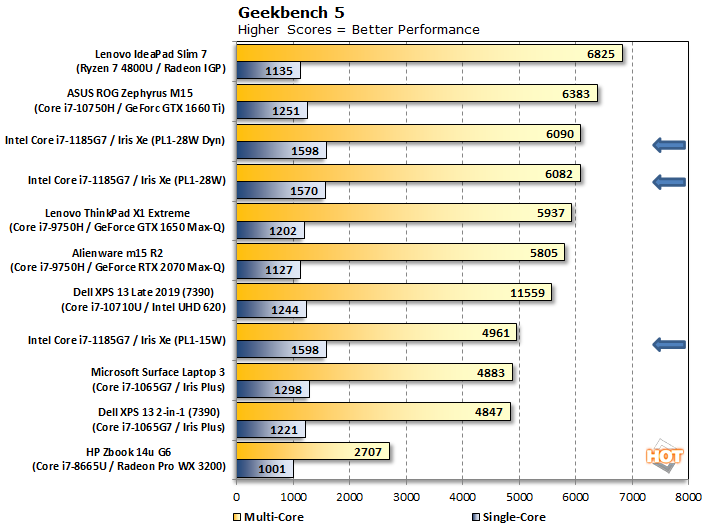
GeekBench is a synthetic measurement of processor throughput but, like the following Cinebench runs, gives us the ability to put single or multithreaded workloads on a system's CPU. Remember too, that we have a mix of 4, 6 and 8-core mobile processors represented here. Regardless, now we begin to see how performance can scale with Tiger Lake and also how strong TGL is with respect to single core throughput. The Core i7-1185G7 puts up 23% more single threaded performance than the fastest Ice Lake-based Core i7-1065G7 score here and it's 40% ahead of AMD's Ryzen 7 4800U for single core performance. In multi-core throughput, our quad-core Tiger Lake test vehicle performs within about 10 percent of the 8-core AMD Ryzen 7 4800U at its 28 Watt envelope, but at 15 Watts falls back to the performance of other quad-core CPUs in this test.
|
Cinebench is developed by Maxon, which is better known for its Cinema 4D software employed in professional 3D rendering and animation studios. We specifically employed Cinebench R20's CPU tests here, which test single threaded and multithreaded performance targeted for CPU rendering only, excluding the GPU.
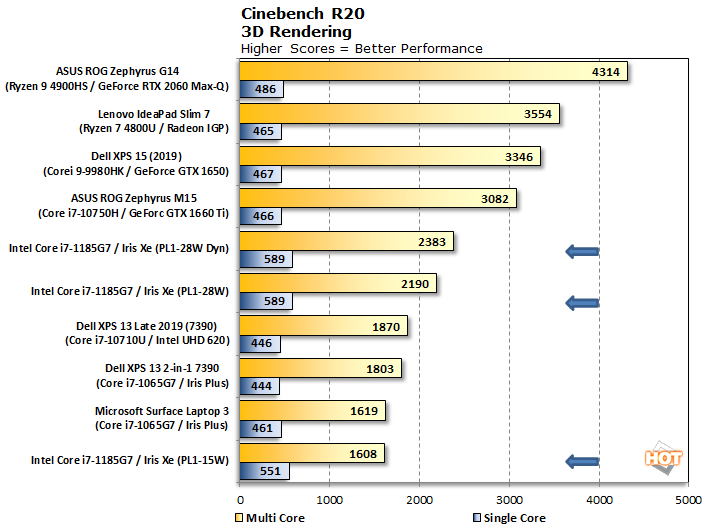
Our Cinebench results are a bit more tightly coupled to core counts, though Tiger Lake once again exhibits very strong single-core throughput that's still over 20 percent ahead of the fastest number we pulled from the AMD Ryzen 9 4900U 8-core machine. Multithreaded throughput is a bit odd at Tiger Lake's PL1-15 Watt setting here, however, and actually drops in below a similar 4-core Ice Lake machine. Multiple test runs didn't vary much, so it didn't seem like a thermal saturation issue for the TGL pre-production system but obviously, for Cinebench multithreaded workloads, the 28 Watt envelope for Tiger Lake is much more favorable.
|
PCMark 10 uses a mix of real-world, free open source applications like Libre Office and GIMP in specific workloads to establish how well a given system performs productivity tasks, including image and video editing, web browsing, and OpenOffice document editing. While these scores appear to be a bit scattered, the systems are sorted by their overall PCMark score, which should should take note of in the graph legend.

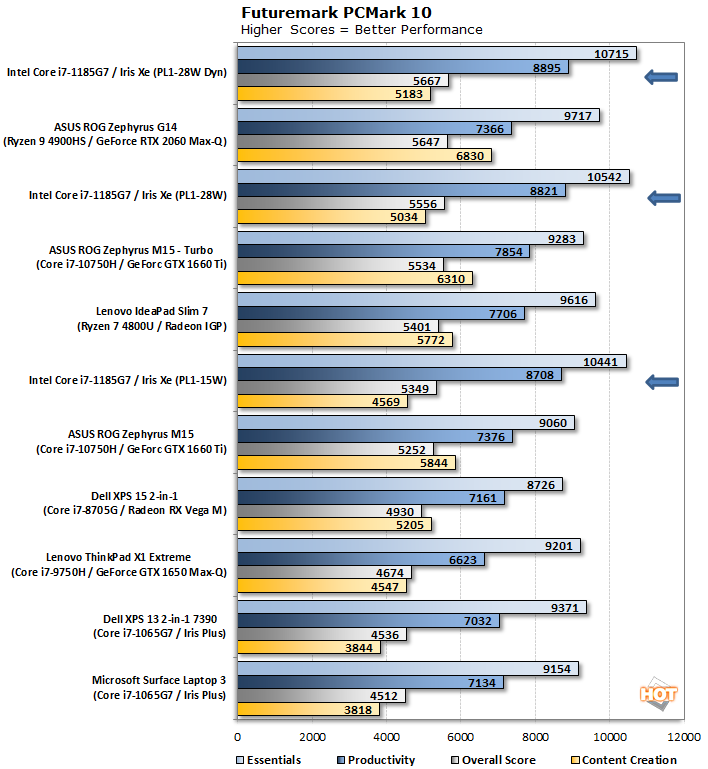
In terms of office productivity tasks with these open source applications, Tiger Lake looks strong again here across the board, regardless of its power settings. Even at 15 Watts it still competes well with the Ryzen 7 4800U, with the exception of its content creation score, which is more closely tied to core counts. Even then, our Core i7-1185G7 quad-core test system is well ahead of the previous generation Ice Lake variants here and at its lower power threshold as well.
|

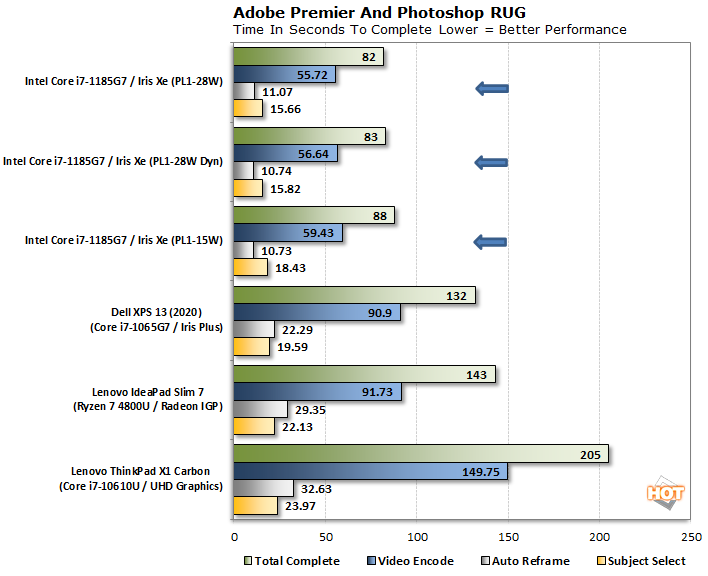
The Office365-based RUG also makes use of Windows Zip to package up files, but it performs a lot of common tasks like pasting images from Excel to Word, exporting Word docs to PDF, as well as a bunch of other mainstream use cases. Here Intel's quad-core Tiger Lake platform dominates the field, including AMD's 8-core Ryzen 7 4000-series offering.
The same holds true for the heavier content creation workloads of the Adobe Premiere and Photoshop RUG that utilizes both still image processing in Photoshop and Adobe Premiere in a typical video productions workload. Though these are fairly quick tests, with the longest run taking a little over three minutes, you can see that Tiger Lake is able to shave nearly a minute off the time of the Ryzen 7 4800U even at its PL1-15 Watt setting, and it finished 44 seconds ahead of the fastest Ice Lake Core i7-1065G7 score here.
Let's get our game on, shall we?
The same holds true for the heavier content creation workloads of the Adobe Premiere and Photoshop RUG that utilizes both still image processing in Photoshop and Adobe Premiere in a typical video productions workload. Though these are fairly quick tests, with the longest run taking a little over three minutes, you can see that Tiger Lake is able to shave nearly a minute off the time of the Ryzen 7 4800U even at its PL1-15 Watt setting, and it finished 44 seconds ahead of the fastest Ice Lake Core i7-1065G7 score here.
Let's get our game on, shall we?


